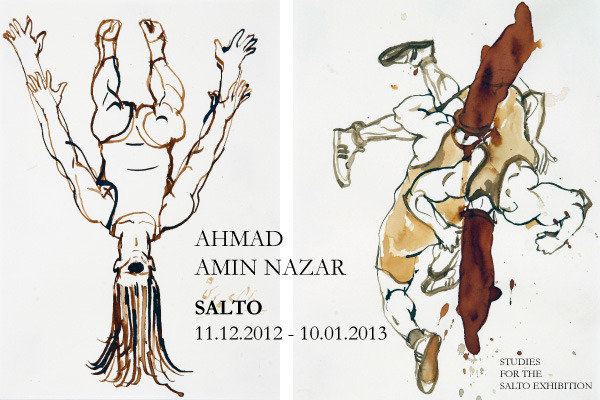Ahmad Amin Nazar
dal 9/12/2012 al 9/1/2013
Segnalato da
Gallery Isabelle van den Eynde
9/12/2012
Ahmad Amin Nazar
Gallery Isabelle van den Eynde, Dubai
Salto. In his new body of works, executed on large-format paper, the artist experiments boldly with the male form, albeit these figures are headless and missing hands and feet, and rendered ambiguously genderless.

Curator and writer Vali Mahlouji writes:
"This exhibition represents a novel direction for painter Ahmad Amin Nazar. In his new body of works, executed on large-format paper, Amin Nazar moves away from recurring myths, heroes, divs and demonic theatrics that have often inhabited his paintings to date. Bold rapid brushstrokes dash off with power, urgency and little hesitation to delineate contours of bodies intertwined and animated in dynamic choreographies that float mid-air in space. Their presence in a void is emphasised by empty space.
Reminiscent of Renaissance and Old Master primi pensieri (first thoughts), Amin Nazar employs his deft brushstrokes freely and intuitively. Painterly gestures animate the surfaces with assured spontaneity and a determined instinctive flair. Drips and spillages of paint are allowed to enhance the energy and urgency of style and the vivacity of figures. Rather than the mastery of topographic human anatomy, the execution of detailed sketches of muscles, tendons and other anatomical features through direct observation of models, Amin Nazar invents complex figurative poses through exercising his imagination. Renaissance master painters drafted their first free, expressive sketches in pen and brown ink as exploratory exercises of new ideas and compositions before moving onto painting a modello or oil sketch to be presented to commissioning patrons. Amin Nazar often thins his own acrylic paint to resemble such sepia-black ink.
Further echoing the Masters' tradition, collectively, the works assemble as disegni for a single whole. Like building blocks of a single epic composition, the exhibition summarily resembles a collection of disegni fitting one single idea. Emphasizing the raw momentum of ideas in progress, Amin Nazar leaves barefoot prints and shoe scruffs on the papers where he has tread over them, spiriting the surface of the paper with his presence and evoking a certain intimacy between the surface and the spectator. Traversing traditions, the artist here simultaneously references late eighteenth- and early nineteenth-century Japanese painters like Katsushika Hokusai, who amongst many works of portraiture and landscape also depicted elaborate erotic encounters.
Across these large-scale compositions, Amin Nazar experiments boldly with the male form, albeit these figures are headless and missing hands and feet, and rendered ambiguously genderless. Contortions of the torsos and inhibiting limbs obscure genitalia. Despite intended ambiguities, masculine energy predominates in these pure studies of bodies in action. The figures wrestle, embrace, violate, battle, dance and dominate depending on which way each drawing is viewed. Amin Nazar painted them from all sides. The large paper sheets were laid onto his studio floor and worked on from above and all around. The artist is keen to exploit all ambiguity and to manipulate his audience with multiple readings. His signature is designed to be legible from three sides and small arrows indicate that each work (with two exceptions) may be hung and viewed from three different directions. Depending on the direction, each view presents a unique dynamic between the figures. A figure may appear to be assaulting or protecting another depending purely on the direction of view. Both figures may often appear suspended or in free fall. Across aggression-seduction trajectories, sensual rhythms play out against violent offensives and precarious fluctuations."
Central to the artist's enquiry is the very intertwining of the figures, their interdependency, their symbiotic attachedness. Wrestling becomes a metaphor for internal (self and its shadow) and external conflict and a background for elaborating aggression, eroticism, homo-eroticism, and the salto mortale—a giant leap into the unknown.
Amin Nazar (b. 1955, Iran) studied fine art in Tehran, and after eight years in Germany, upon returning to Iran, began exploring relationships between miniaturist traditions and Iranian literature, namely through etching. He belongs to a lost generation of Iranian artists who, due to historical circumstances, vanished in the midst of ideological, political, cultural and violent turmoil. Although tutoring younger generations at university and at home for many years, he became profoundly reclusive, seeking refuge in his studio, and in his raw, instinctive expressions.
Gallery Isabelle van den Eynde
Al Quoz 1, Street 8, Al Serkal Avenue #13, Dubai, UAE P.O. Box 18217
Opening hours:
Saturday-Thursday 10am-7pm



